Post by Kayla Dagnino, undergraduate in Psychology pursuing an Interdisciplinary Neuroscience minor at Portland State University. Kayla joined outreach visits with Northwest Noggin this fall.
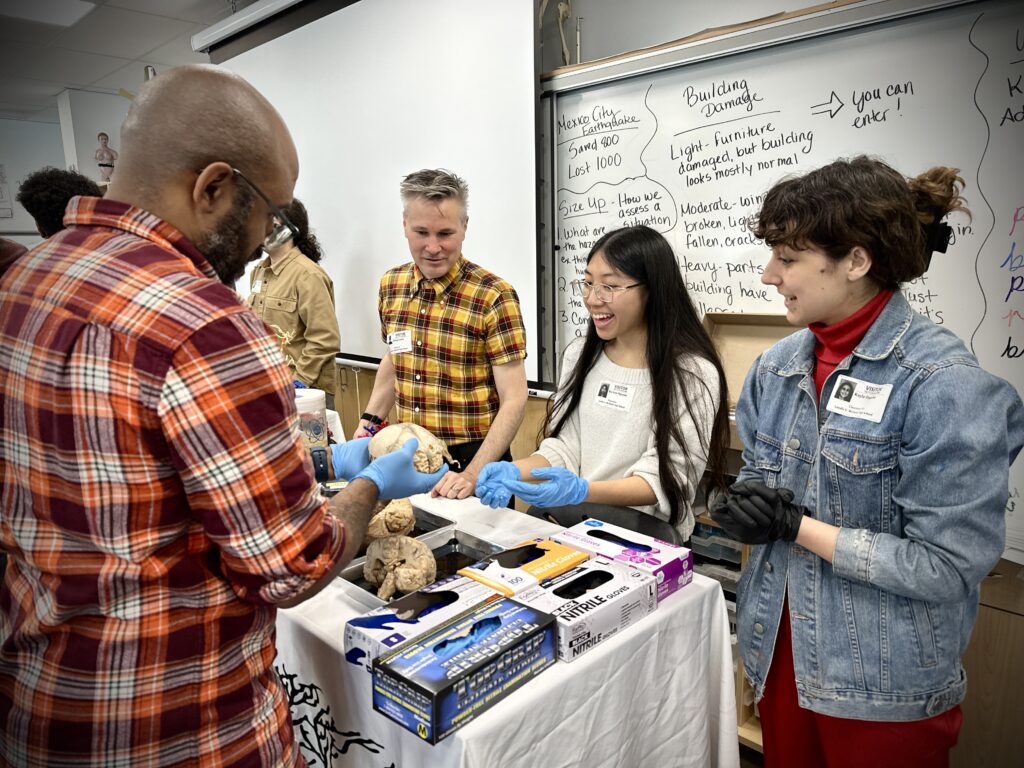
Visiting Leodis McDaniel High School in Portland, Oregon, I noticed that the students were very inquisitive about Attention Deficit Hyperactivity Disorder (ADHD) and what it looks like in the brain and body. Several students had questions revolving around medications that treat ADHD and asked if there were ways to treat symptoms of ADHD without medication.
“Attention-deficit/hyperactivity disorder (ADHD) is one of the most common neurobehavioral disorders of childhood and can profoundly affect children’s academic achievement, well-being, and social interactions.”
― American Academy of Pediatrics
As a person who works at a behavioral health facility, I interact with youth diagnosed with ADHD every day. So I decided to do a deep dive into how ADHD manifests in the nervous system, how typical medications affect people, and how to implement better focus without medication.
LEARN MORE: Types of Mental Health Professionals
LEARN MORE: Give until It Hurts: An Exploratory Analysis of Mental Health Workers’ Wellness
LEARN MORE: Job satisfaction among mental healthcare professionals
What is ADHD Phenotypically (Symptoms of ADHD)?

So, what exactly is Attention Deficit/Hyperactivity Disorder?
ADHD is characterized by a lack of an ability to focus (termed “inattention”) and hyperactivity. As people get older, their hyperactivity may decline, but their inattention persists. There are now several subtypes listed in the Diagnostic and Statistical Manual of Disorders (the DSM, which is now at version five (DSM-VTR)). Let’s take a look further into the symptoms. From the DSM-V:

An inability to start tasks that an individual deems unexciting or understimulating is considered a sign of executive dysfunction, a set of skills partly reliant on our brain’s pre-frontal cortex (PFC). Though how exciting or stimulating is schoolwork, particularly when geared towards preparation for standardized testing? And what kind of classroom is the child experiencing? Are there lots of distractions?
People with ADHD often have decent long-term memory; however, when they are doing a task, they will forget what they’re doing briefly or they “zone out.” They also get distracted and forget what they were trying to do. A lack of sleep can worsen these symptoms.

Someone with ADHD can appear to have a lot of outward energy, and an inability to sit still.
Males, when diagnosed, tend to show more hyperactivity than females diagnosed with ADHD, which has led to an acknowledged under diagnosis of the disorder in girls. There are additional symptoms and criteria for diagnosis, described in more detail at the links below.
LEARN MORE: Diagnosing ADHD
LEARN MORE: A Review of Attention-Deficit/Hyperactivity Disorder in Women and Girls: Uncovering This Hidden Diagnosis
Some individuals diagnosed with ADHD, particularly adolescents and adults, report experiencing hyperfocus: the ability to really focus intently and persistently on something that you are interested in…like brains!
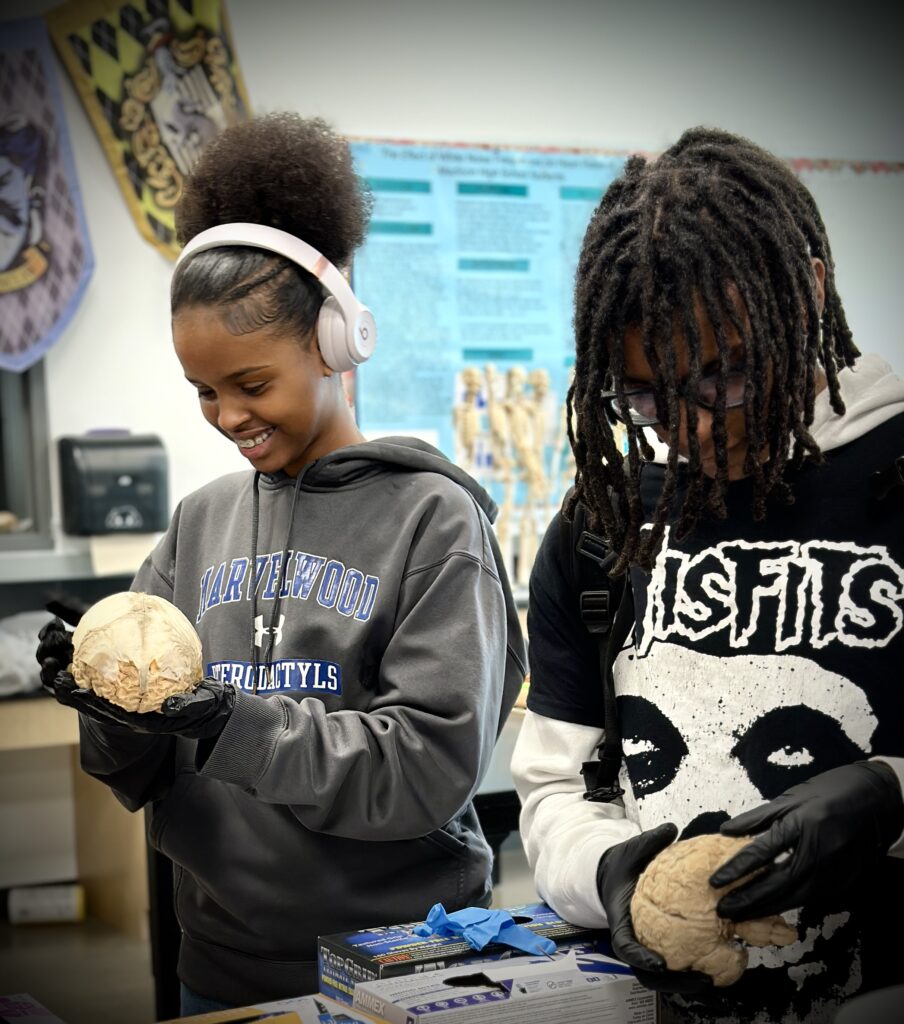
This could also be a sign of executive dysfunction, as it’s often viewed as an inability to shift attention, but I saw value in this experience. At this point there is still limited research on hyperfocus, which is also experienced by those without ADHD.

But I noticed in the classroom that making art and doing things that you enjoy seemed to help brains focus. Students working on art projects and holding brains were very engaged and were able to take in information even early in the morning!
LEARN MORE: Attention-Deficit/Hyperactivity Disorder
LEARN MORE: Changes in the Definition of ADHD in DSM-5: Subtle but Important
LEARN MORE: ADHD & How Anyone Can Improve Their Focus
LEARN MORE: Improving Outcomes for Youth with ADHD
LEARN MORE: NIH researchers unlock pattern of gene activity for ADHD
LEARN MORE: Hyperfocus: the forgotten frontier of attention
LEARN MORE: Hyperfocus symptom and internet addiction in individuals with attention-deficit/hyperactivity disorder trait
LEARN MORE: Hyperfocusing as a dimension of adult attention deficit hyperactivity disorder
LEARN MORE: A Dive Into Habits
What Does ADHD Look Like in the Brain?
There are several different ways that ADHD might show up in the brain. There is a lot of research underway on this disorder, funded by the National Institutes of Health (NIH). ADHD can be related to differences in the Reticular Activation System (RAS), differences in the basal ganglia, and/or issues with a neurotransmitter known as dopamine.

LEARN MORE: Exploring ADHD…with science!
LEARN MORE: What is the National Institutes of Health?
LEARN MORE: ADOLESCENT BRAIN COGNITIVE DEVELOPMENT STUDY
Reticular Activating System (RAS)
Let’s first take a look into what the RAS is and how it affects individuals with ADHD!
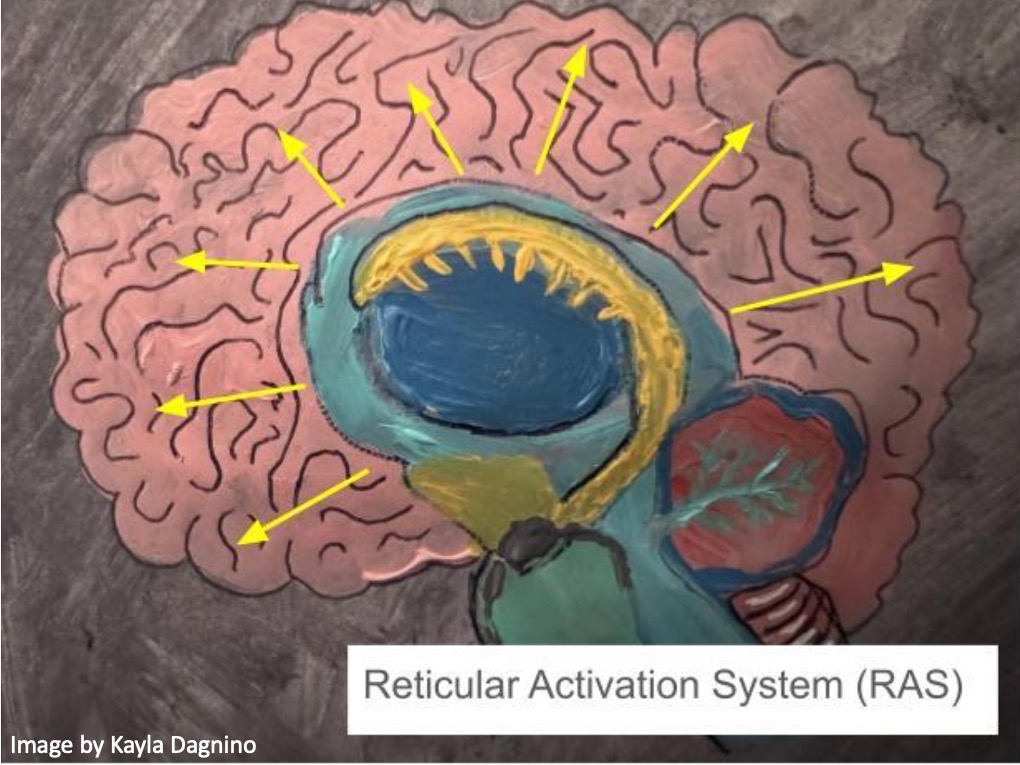
The Reticular Activation System is an extensive set of neurons with their cell bodies in the brainstem and axons spreading throughout the brain. The RAS is directly involved in our sleep-wake cycle (or circadian rhythms), alertness, and regulating arousal.
Individuals who are not affected with Attention Deficit Disorder are able to filter out distracting stimuli with this system and can focus on relevant stimuli. They are also able to sustain focus at optimal energy (arousal) levels. With ADHD, there is often a dysfunction in maintaining energy levels and difficulty filtering out distracting stimuli.
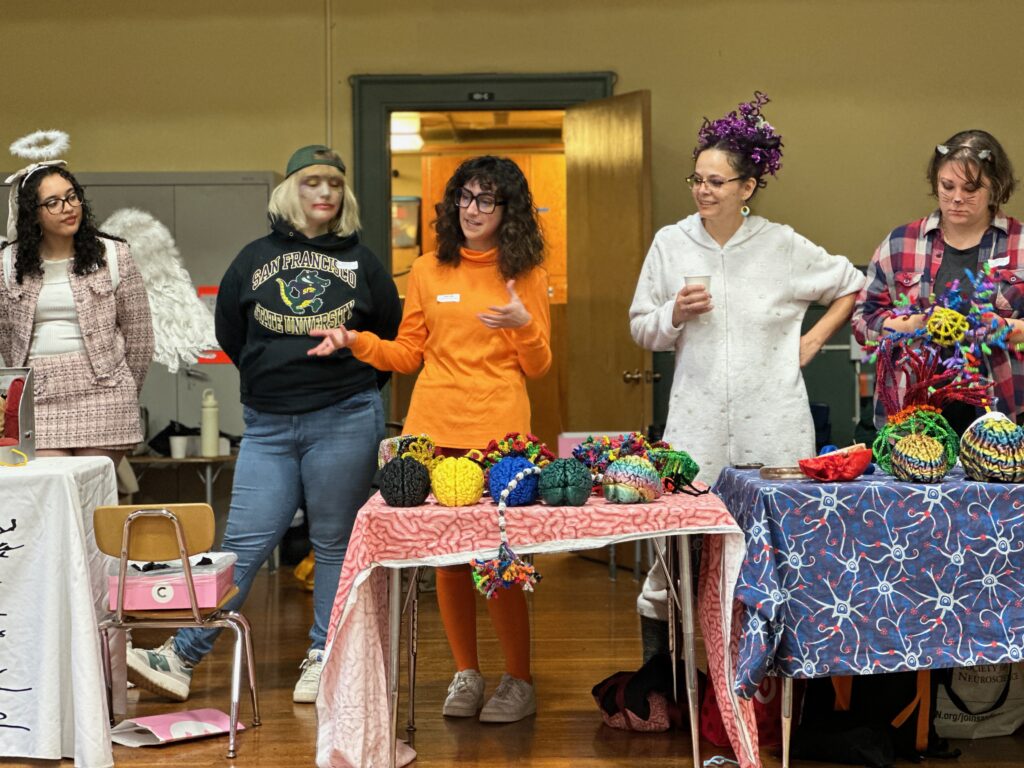
When an individual has ADHD, they are either overly responsive to stimuli or under-responsive to stimuli.
LEARN MORE: Cortical activity patterns in ADHD during arousal, activation and sustained attention
Basal Ganglia
“Pathology of the basal ganglia has been consistently implicated in the pathogenesis of attention-deficit/hyperactivity disorder (ADHD). The basal ganglia are core components of richly interconnected ‘loops’ that connect the cortex and thalamus, supporting many cognitive processes impaired in ADHD…”
― Philip Shaw et al (2023)
The basal ganglia are a set of subcortical (below the cortex, or outer “bark” of the brain) structures that are synaptically linked together. The basal ganglia get input from the cortex, including the pre-frontal cortex about your plans and social decisions, and that input runs through the basal ganglia and then back to cortex via another important subcortical structure called the thalamus.
There are several circuits in these cortex-basal ganglia-thalamus-cortex connections, including one that puts the brakes on behavior, and another that hits the accelerator pedal.
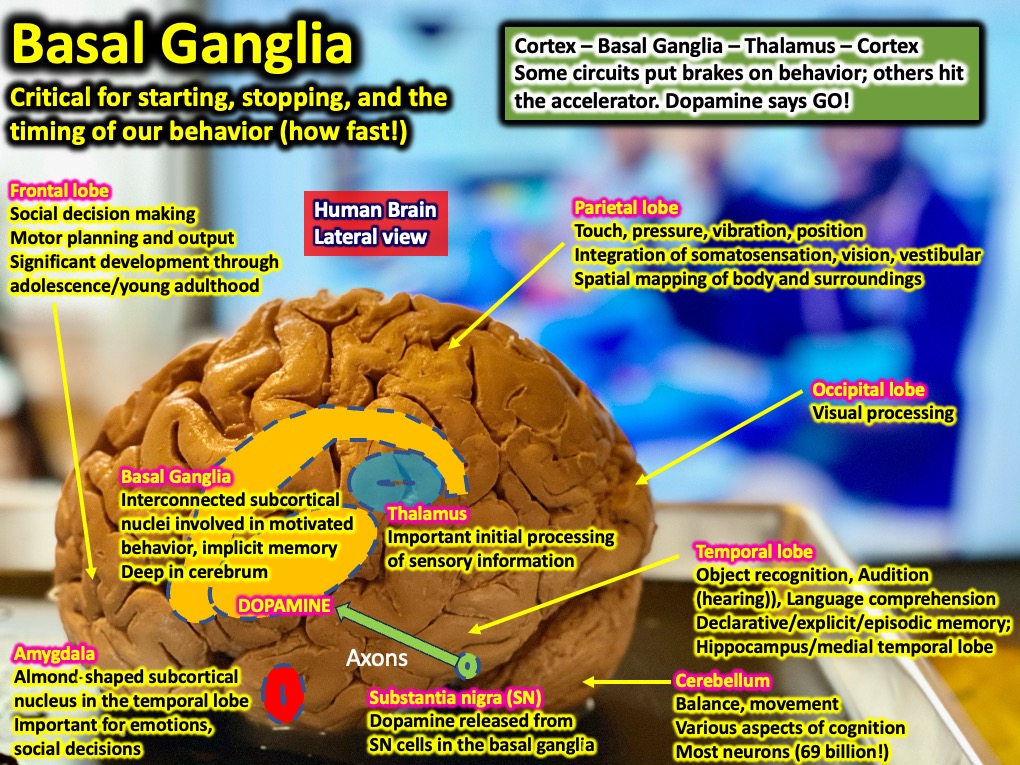
Research is revealing differences in basal ganglia circuitry in those diagnosed with ADHD.
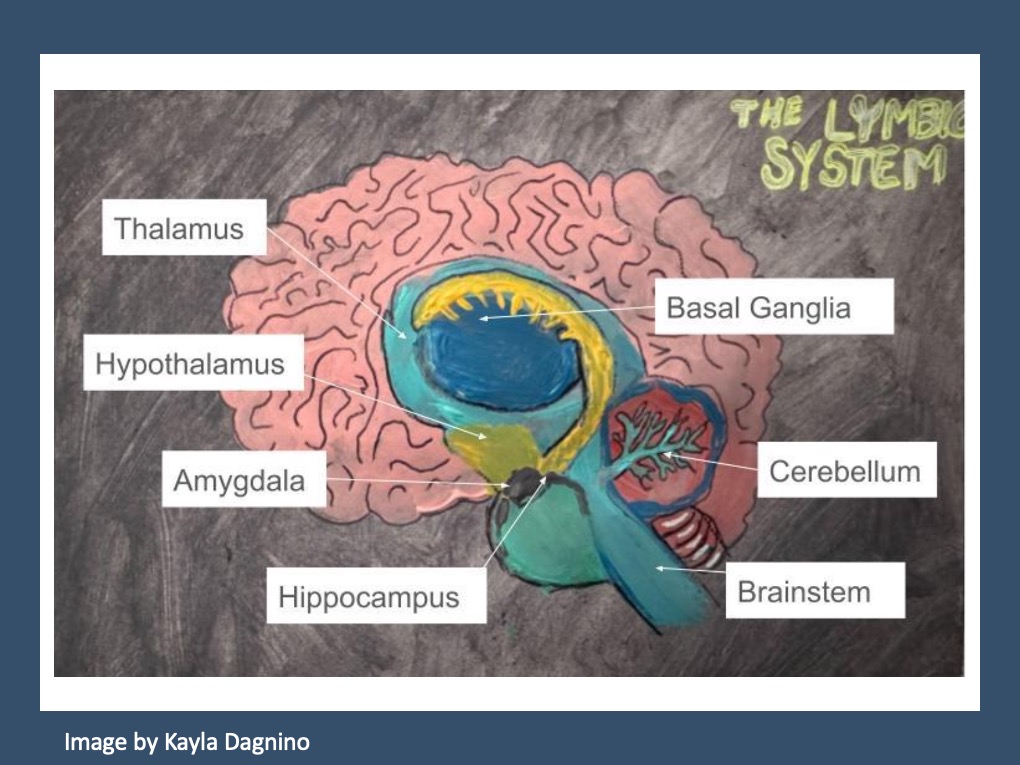
LEARN MORE: NIH researchers identify brain connections associated with ADHD in youth
LEARN MORE: Mapping the development of the basal ganglia in children with attention-deficit/hyperactivity disorder
LEARN MORE: Basal Ganglia Volume and Shape in Children With Attention Deficit Hyperactivity Disorder
LEARN MORE: Overview of Attention Deficit Hyperactivity Disorder in Young Children
The Role of Dopamine
Dopamine is a neurotransmitter associated with our reward system.
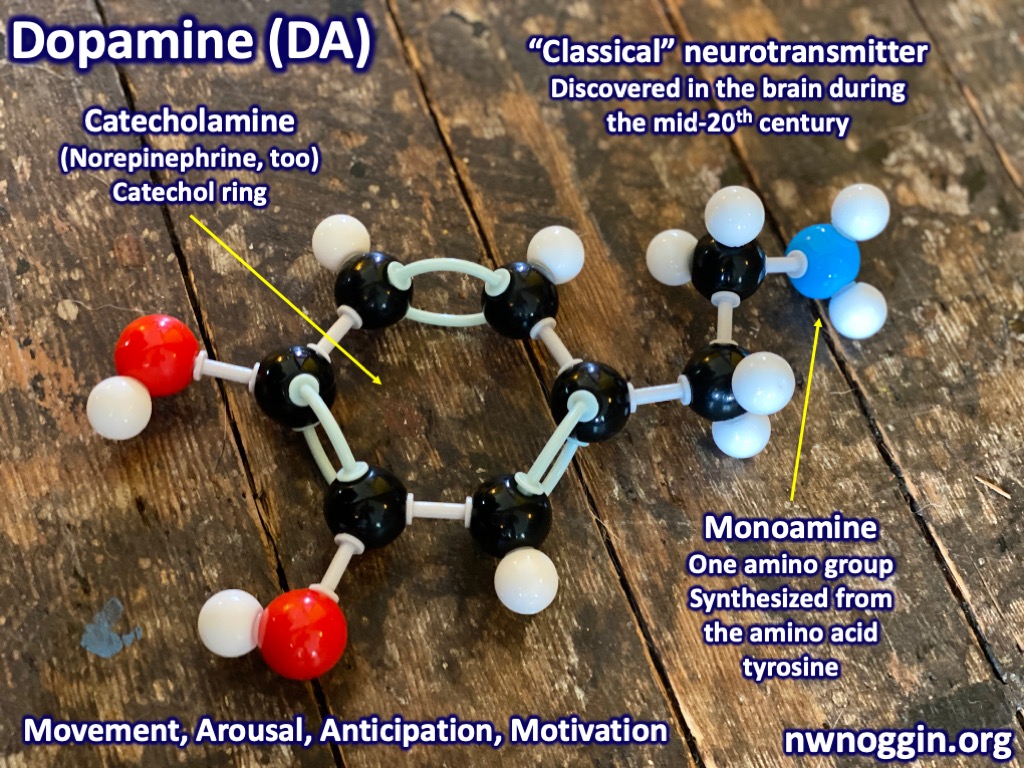
Dopamine also plays an important role in how individuals are affected by ADHD. It’s often mistaken for serotonin, which is a related neurotransmitter with well-studied impacts on psychological health and mood; however, they often work together. Dopamine is usually released when we accomplish a new or challenging goal – or anticipate accomplishing or obtaining something we desire.
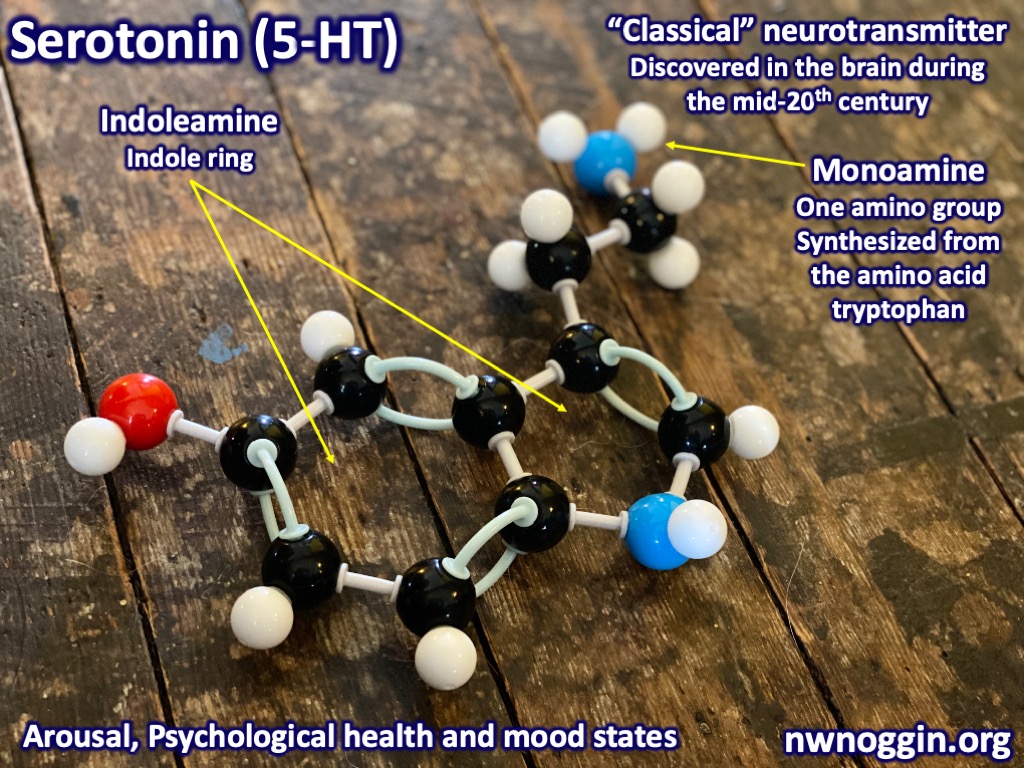
Are you motivated? Do you feel a powerful sense of anticipation that requires you to act? Our brains might spike dopamine when we’re about to finish an assignment that we’re proud of and which just needs a few more edits or when we reach for a tasty treat that we’ve been craving for a while!
In the ADHD brain, there are differences in dopamine release in the brain.
For activities that are difficult or not fun for the person who has ADHD, it can be extremely challenging to find tasks rewarding or motivating, and it’s not easy to get started on difficult tasks, which is how some of the symptom of inattention/executive dysfunction might occur.
LEARN MORE: The brain anatomy of attention-deficit/hyperactivity disorder in young adults
LEARN MORE: Attention-deficit-hyperactivity disorder and reward deficiency syndrome
What medications treat ADHD, and do they work?
The most typical drugs used to treat ADHD are stimulants.
Stimulant drugs are associated with increasing arousal and alertness. Some examples of stimulants used to treat ADHD are Adderall (dextroamphetamine and amphetamine) and Ritalin (methylphenidate).
You might be thinking: How would stimulants work on someone who is already very hyperactive? Wouldn’t that make them more hyper?
Remember that ADHD symptoms are worsened by lack of sleep, or increased stress and anxiety. When people aren’t rested, it’s much harder to organize brain networks that must coordinate their activity in order to pay attention, and successfully complete tasks. Boosting alertness – boosting that reticular activating system – can reduce symptoms.
LEARN MORE: Effects of Stimulants on Brain Function in Attention-Deficit/Hyperactivity Disorder
LEARN MORE: Practice Pearls for Stimulant Treatment of Attention-Deficit/Hyperactivity Disorder in Youth
LEARN MORE: How do stimulant treatments for ADHD work? Evidence for mediation by improved cognition
Adderall and Ritalin increase dopamine release and serotonin as neurotransmitters in the synaptic cleft.

Drugs used to treat ADHD also increase availability of another neurotransmitter called norepinephrine.
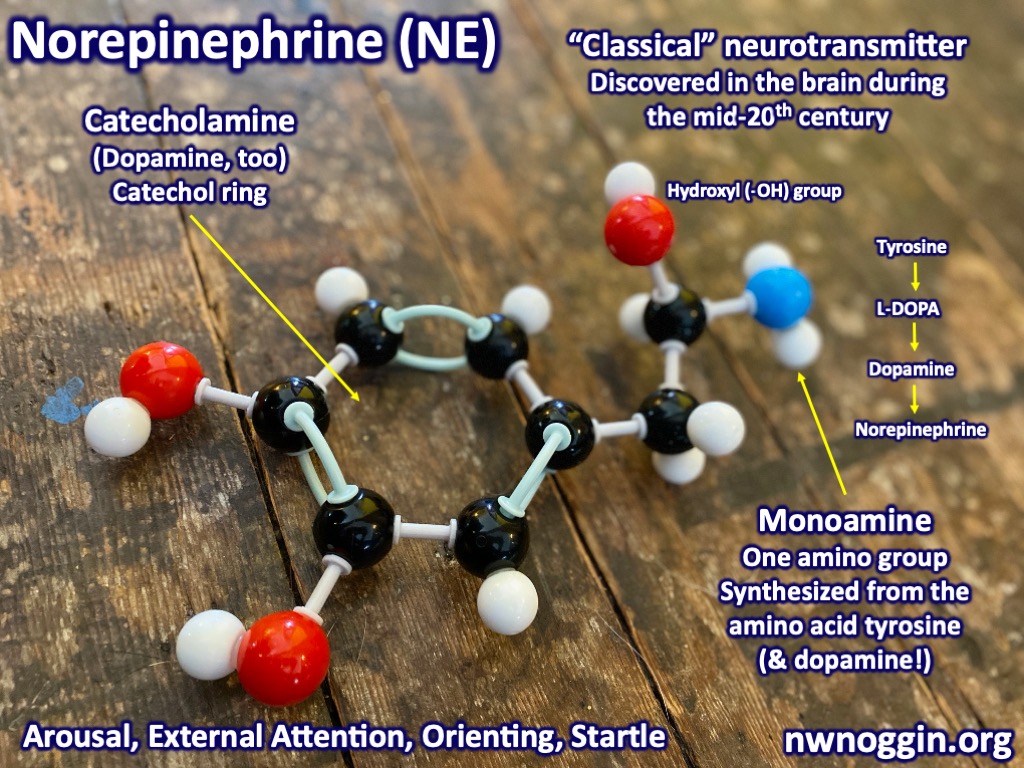
Norepinephrine is a neurotransmitter that increases alertness and focus, as well as impacting other functions in the body like maintaining blood pressure. These drugs work by allowing norepinephrine to be more available in the synaptic cleft rather than it being stored in the neuron.
Can we treat ADHD without drugs?
Students were really interested in this question! Many DID NOT like taking drugs for ADHD.
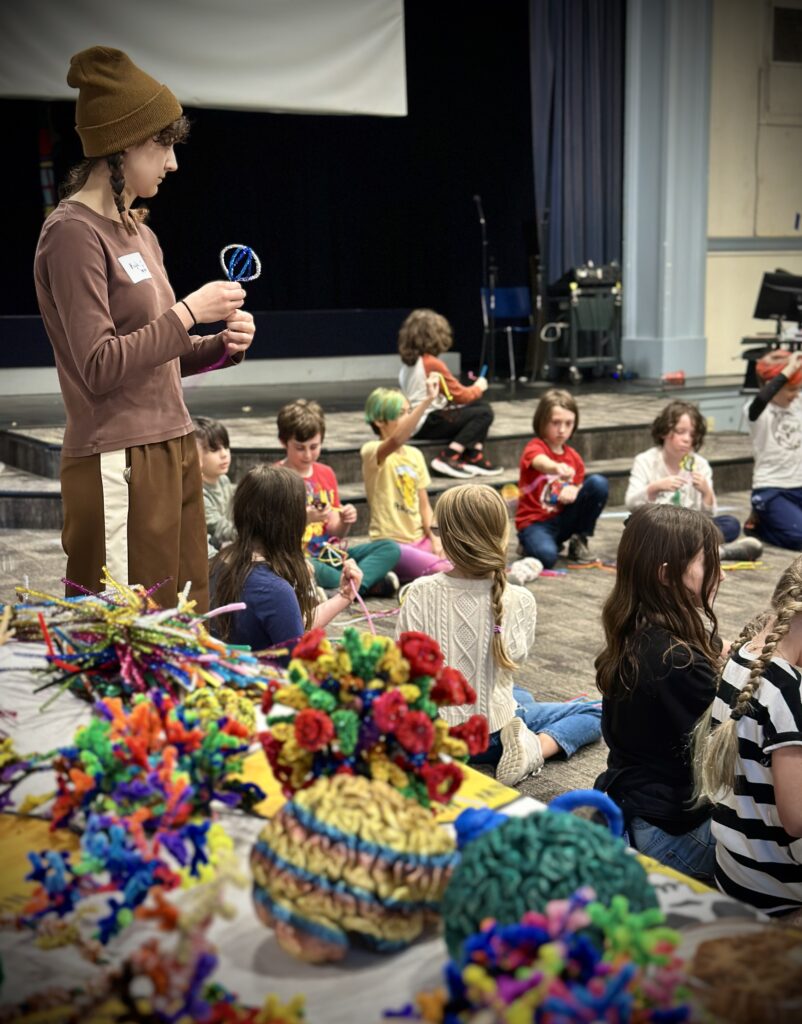
Research has reported several unpleasant side effects to drug therapy, including gastrointestinal symptoms (for example, indigestion and heartburn, decreased appetite, bloating, abdominal pain and constipation), eye (or ocular) symptoms (e.g., redness, dry eyes, blurry vision), and cognitive impacts (sleep disturbances, development of tolerance to the drugs, and an increased risk of psychosis).
LEARN MORE: Associations of sleep disturbance with ADHD: implications for treatment
LEARN MORE: Effects of Methylphenidate on Sleep Functioning in Children with Attention-Deficit/Hyperactivity Disorder
However there are ways to help reduce symptoms WITHOUT substances!
LEARN MORE: My child has been diagnosed with ADHD — Now what?
Sleep!
Making sure that you get enough sleep helps maintain your attention by having a more rested and ready Reticular Activation System, and better coordinated attention networks. This can help with focus, clarity, and memory. The American Academy of Pediatrics now recommends behavioral assessments and approaches (including efforts to improve sleep quality) before drug therapy in young children.
Diagnoses of ADHD also decline significantly whenever high schools shift their start times to later in the morning, allowing adolescents who are naturally up into the wee hours to get more critical sleep before school. Additional policy changes, including the adoption of Permanent Standard Time (not Daylight “Savings”) would likely help too.
LEARN MORE: Hey Vancouver: Let Kids Sleep!
LEARN MORE: Permanent Standard Time is best for your brain
LEARN MORE: ADHD and Sleep: Recent Advances and Future Directions
LEARN MORE: Sleep Disturbances in Adolescents with ADHD: A Systematic Review and Framework for Future Research
LEARN MORE: Managing Sleep in Adults with ADHD: From Science to Pragmatic Approaches
LEARN MORE: Psychosis with use of amphetamine drugs, methylphenidate and atomoxetine in adolescent and adults
Hydration!
Brain fog from dehydration can also cause inattention. Your brain needs a lot of water to function properly. When there are decreases in water in your system, cognitive function goes down.

LEARN MORE: Cognitive performance and dehydration
LEARN MORE: Effects of Dehydration and Rehydration on Cognitive Performance and Mood
Engaging Activities!
Engaging in activities that you enjoy or genuinely care about can significantly boost your ability to focus. Smaller groups are also beneficial, as larger classrooms can be more distracting. Art really drew students in! At McDaniel High School, and at other schools I visited, students displayed so much enthusiasm for neuroscience thanks (I observed) to the integration of art. Art allowed their minds to wander freely and explore questions that got them curious. It helped a ton with maintaining interest and attention!
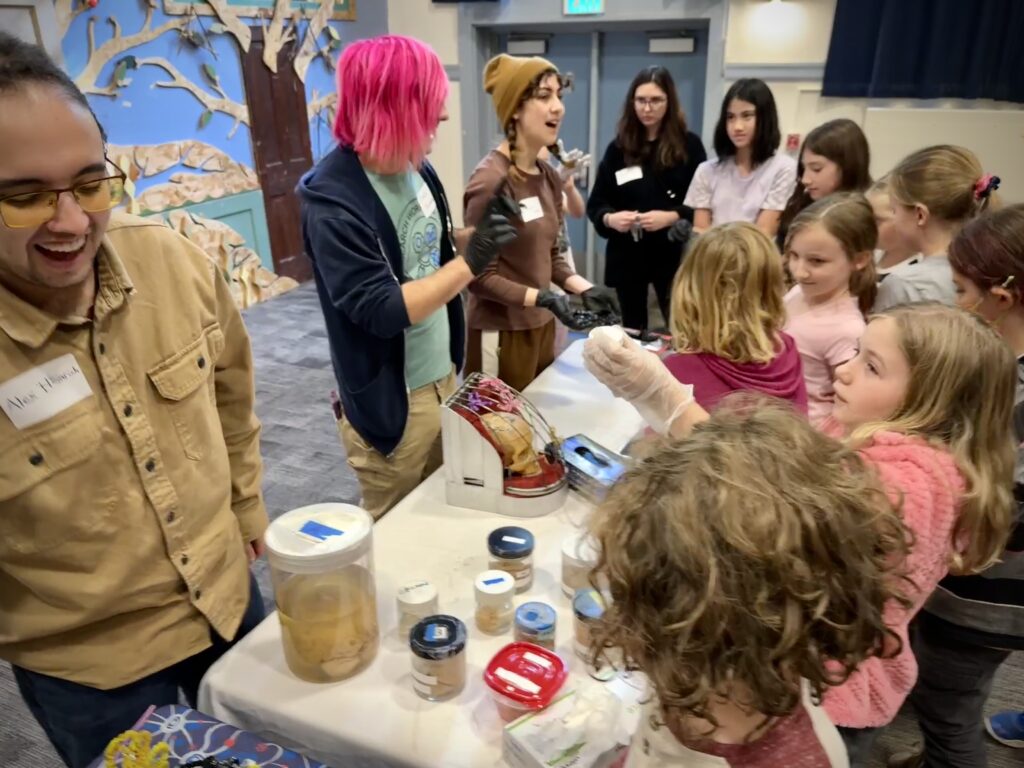
LEARN MORE: Impact of Group Size on Classroom On-Task Behavior and Work Productivity in Children With ADHD
LEARN MORE: Creativity in ADHD: Goal-Directed Motivation and Domain Specificity
LEARN MORE: Children with ADHD draw-and-tell about what makes their life really good
LEARN MORE: Art of Learning – An Art-Based Intervention Aimed at Improving Children’s Executive Functions
LEARN MORE: Universal Design for Learning for Children with ADHD
Nature!
“Substantial research conducted among non-ADHD populations has shown that ‘symptoms’ of ADHD—inattention and impulsivity—are reduced after exposure to natural views and settings…”
― Frances E Kuo and Andrea Faber Taylor

Being out in nature and seeing the color green with your eyes creates a sense of calmness and reduces symptoms of impulsivity. Studies have shown that apartments that are located in areas surrounded by forests or trees have better outcomes for ADHD symptom reduction rather than apartments that are not surrounded by green. Anecdotally, working in a behavioral health facility that focuses on horticulture therapy, I have seen firsthand reductions of ADHD symptoms in young children who work in and walk around the garden and other greenspaces. Living in the Pacific Northwest has its benefits!
LEARN MORE: Could Nature Contribute to the Management of ADHD in Children? A Systematic Review
LEARN MORE: A Potential Natural Treatment for Attention-Deficit/Hyperactivity Disorder: Evidence From a National Study
LEARN MORE: Effect of physical activity on attention in school-age children with ADHD
LEARN MORE: Bathing your brain
ADHD symptoms, including a lack of focus and impulsivity can be difficult to manage in school.

Getting proper sleep, hydration and going outside are crucial medication-free ways to alleviate ADHD symptoms. Outreach with Northwest Noggin has shown me that allowing young brains to roam and be curious and make art also increases focus and engagement in learning. I would like to thank the students I met for being so inquisitive and fun!


